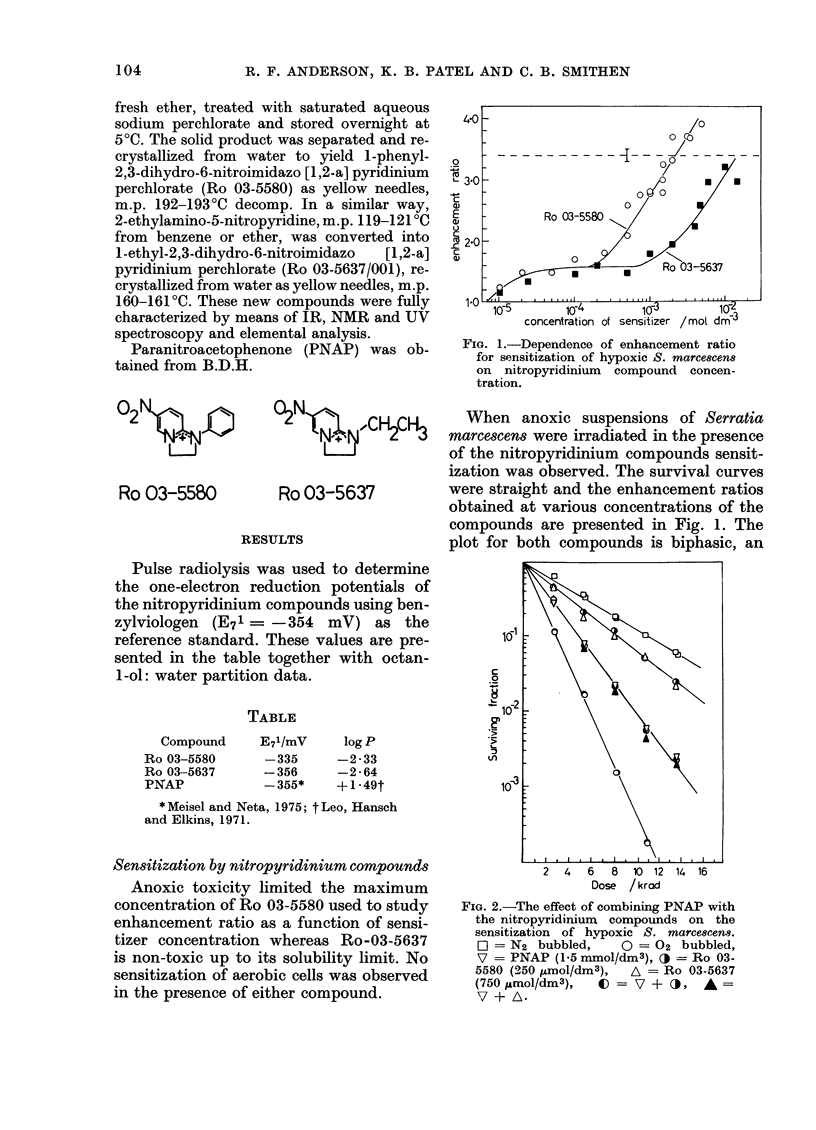Abstract
The two nitropyridinium compounds tested sensitize hypoxic Serratia marcescens to irradiation up to the oxygen enhancement level by two components which can be separated as a function of compound concentration. Sensitization above the initial plateau level is in order of their determined one-electron reduction potentials, Ro 03-5580 (E 7 1 = -335 mV) being more efficient than Ro 03-5637 (E 7 1 = -358 mV). Additivity in sensitization up to a maximum enhancement level of 2.1 +/- 0.1 is found on combining these hydrophilic compounds at concentrations to give sensitization at the plateau level, with the hydrophobic sensitizer paranitroacetophenone (PNAP). It is concluded that the nitropyridinium compounds and PNAP sensitize the same site.
Full text
PDF



Selected References
These references are in PubMed. This may not be the complete list of references from this article.
- Adams G. E., Asquith J. C., Dewey D. L., Foster J. L., Michael B. D., Willson R. L. Electron affinic sensitization. II. Para-nitroacetophenone: a radiosensitizer for anoxic bacterial and mammalian cells. Int J Radiat Biol Relat Stud Phys Chem Med. 1971;19(6):575–585. doi: 10.1080/09553007114550751. [DOI] [PubMed] [Google Scholar]
- Adams G. E., Flockhart I. R., Smithen C. E., Stratford I. J., Wardman P., Watts M. E. Electron-affinic sensitization. VII. A correlation between structures, one-electron reduction potentials, and efficiencies of nitroimidazoles as hypoxic cell radiosensitizers. Radiat Res. 1976 Jul;67(1):9–20. [PubMed] [Google Scholar]
- Anderson R. F., Patel K. B. Radiosensitization of Serratia marcescens by bipyridinium compounds. Int J Radiat Biol Relat Stud Phys Chem Med. 1977 Nov;32(5):471–479. doi: 10.1080/09553007714551231. [DOI] [PubMed] [Google Scholar]
- Epp E. R., Weiss H., Kessaris N. D., Santomasso A., Heslin J., Ling C. C. Oxygen diffusion times in bacterial cells irradiated with high-intensity pulsed electrons: new upper limit to the lifetime of oxygen-sensitive species suspected to be induced at critical sites in bacterial cells. Radiat Res. 1973 May;54(2):171–180. [PubMed] [Google Scholar]
- Jones R. W., Garland P. B. Sites and specificity of the reaction of bipyridylium compounds with anaerobic respiratory enzymes of Escherichia coli. Effects of permeability barriers imposed by the cytoplasmic membrane. Biochem J. 1977 Apr 15;164(1):199–211. doi: 10.1042/bj1640199. [DOI] [PMC free article] [PubMed] [Google Scholar]
- Shenoy M. A., Asquith J. C., Adams G. E., Micheal B. D., Watts M. E. Time-resolved oxygen effects in irradiated bacteria and mammalian cells: a rapid-mix study. Radiat Res. 1975 Jun;62(3):498–512. [PubMed] [Google Scholar]


